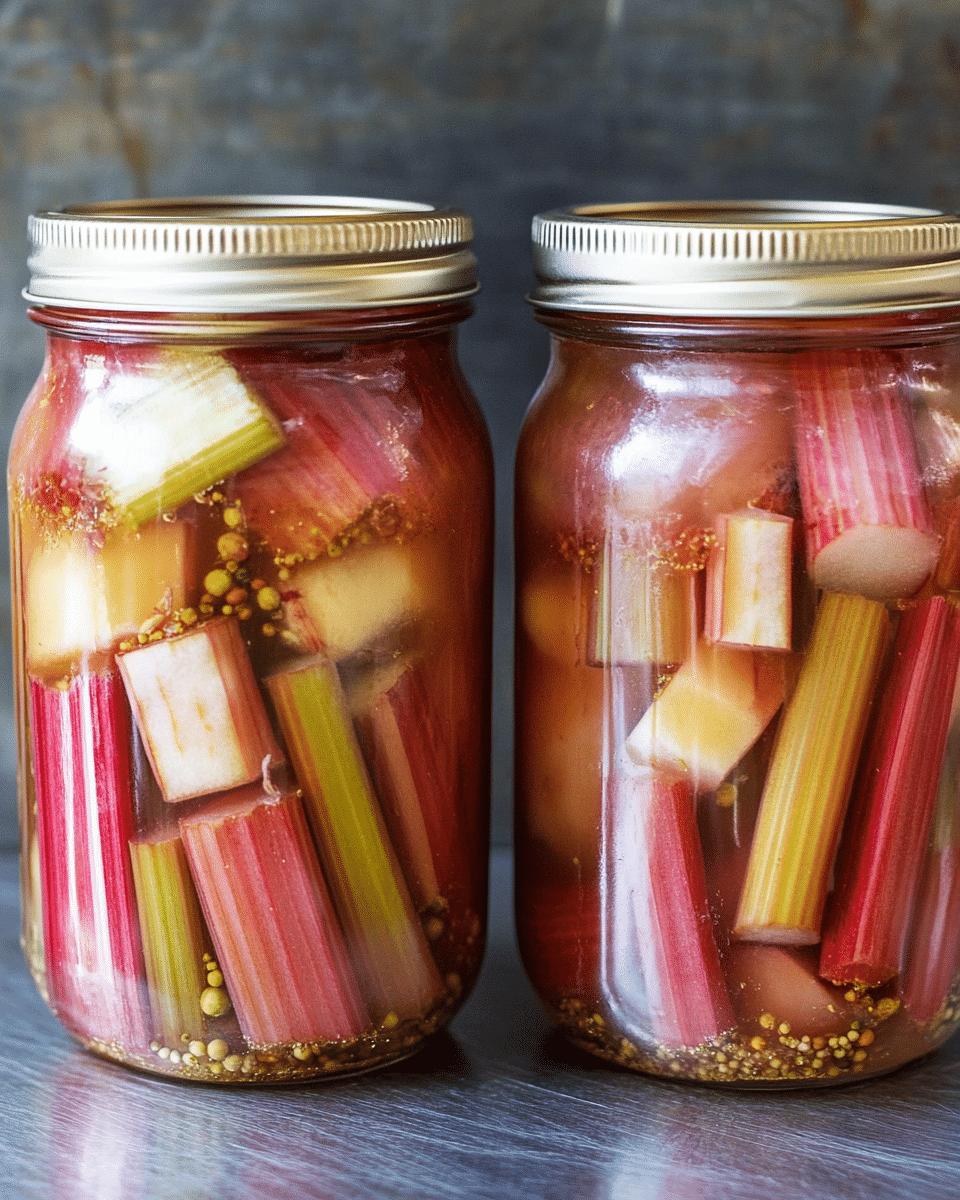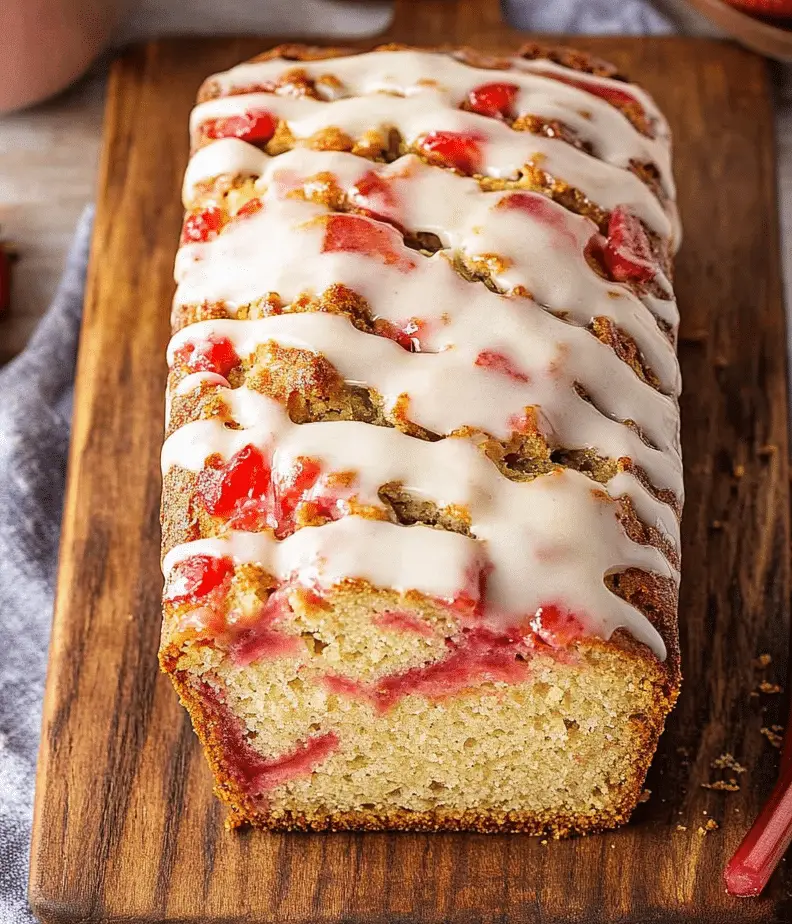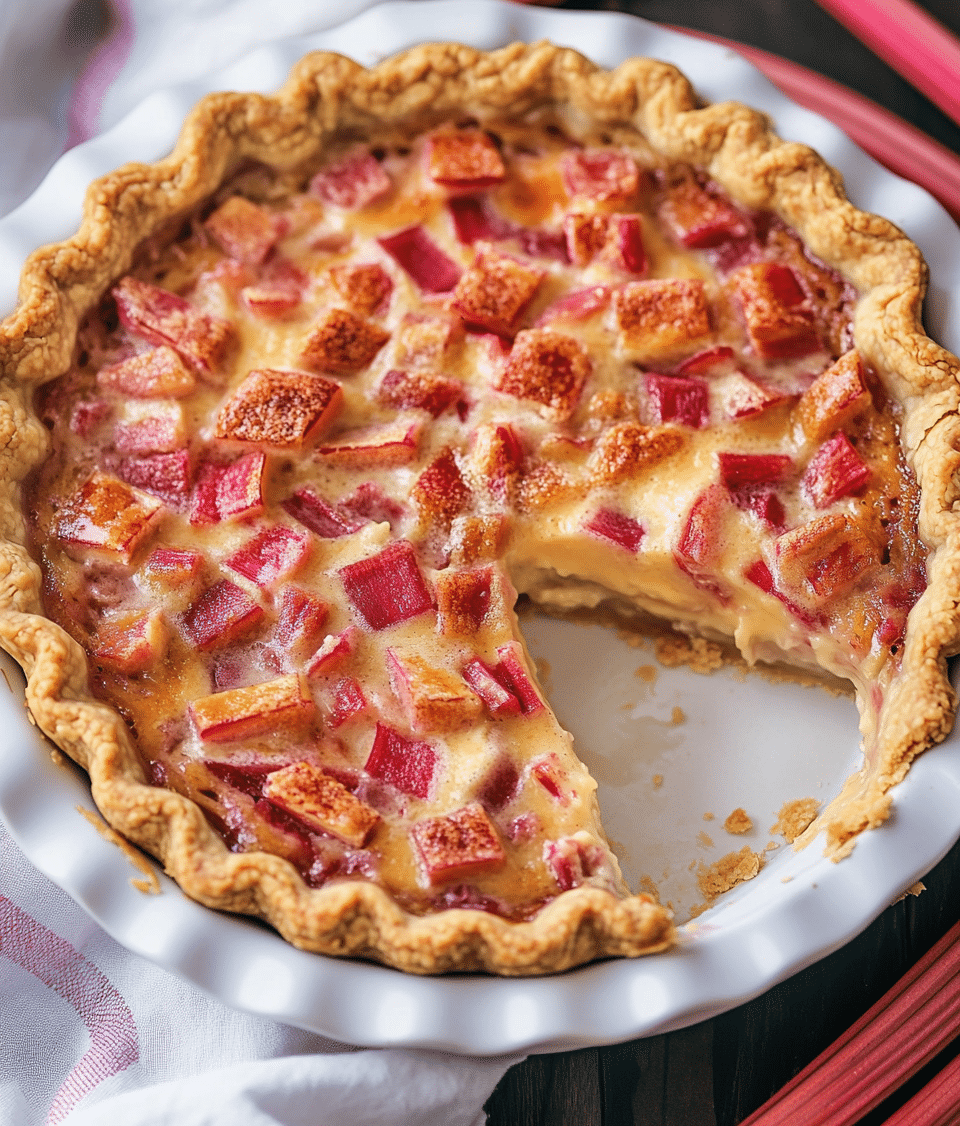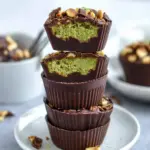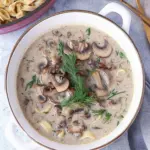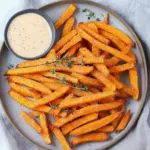A classic old-fashioned pickled rhubarb recipe brings a tangy, sweet, and slightly spicy flavor to your table. Perfect as a unique condiment or a zesty accompaniment to meals, this simple preserve captures the bright, tart essence of fresh rhubarb with a delightful pickled twist.
FULL RECIPE
Ingredients
- 4 cups rhubarb, cut into 2-inch pieces
- 1 ½ cups white vinegar (5%)
- 1 ½ cups water
- 1 ½ cups granulated sugar
- 1 tablespoon pickling salt or kosher salt
- 1 cinnamon stick
- 4 whole cloves
- 1 teaspoon whole allspice berries
- 1 small piece of fresh ginger (optional), sliced
Directions
- Rinse rhubarb and cut into 2-inch pieces. Set aside.
- In a large saucepan, combine vinegar, water, sugar, and salt. Stir over medium heat until sugar dissolves.
- Add cinnamon stick, cloves, allspice berries, and ginger slices to the liquid. Bring to a gentle boil, then reduce heat and simmer for 5 minutes to infuse the spices.
- Place the rhubarb pieces into sterilized jars.
- Pour the hot pickling liquid over the rhubarb, ensuring all pieces are submerged and the spices are evenly distributed.
- Seal the jars and let cool to room temperature before refrigerating.
- Allow the rhubarb to pickle for at least 24 hours before serving for best flavor. Refrigerate and consume within 3 weeks.
Nutritional Information
- Calories: 70
- Total Fat: 0 g
- Saturated Fat: 0 g
- Cholesterol: 0 mg
- Sodium: 150 mg
- Total Carbohydrates: 18 g
- Dietary Fiber: 1 g
- Sugars: 16 g
- Protein: 0 g
- Vitamin A: 0% DV
- Vitamin C: 4% DV
- Calcium: 2% DV
- Iron: 1% DV
History of Pickled Rhubarb
Pickling rhubarb is a tradition that dates back centuries, especially popular in Northern Europe and parts of North America where rhubarb grows abundantly in spring. Historically, pickling was a way to preserve the fresh tartness of rhubarb beyond its short growing season. Early cooks used pickled rhubarb as a tangy accompaniment to rich and heavy winter meals, balancing flavors and adding brightness when fresh fruits were scarce.
Seasonal Availability and Harvesting Rhubarb
Rhubarb is a spring vegetable, with its stalks typically harvested from early spring through early summer. It’s important to pick rhubarb stalks when they are crisp and firm for pickling, avoiding any that are too woody or damaged. The leaves are toxic and must be discarded. Harvesting at the peak of freshness ensures the best flavor and texture in the final pickled product.
Nutritional Benefits of Rhubarb
Rhubarb is low in calories but packed with nutrients, including vitamin K, vitamin C, calcium, and fiber. When pickled, some nutrients may reduce slightly due to heat, but many beneficial antioxidants remain. The pickling process also adds probiotics if fermented naturally, although this recipe uses vinegar for preservation rather than fermentation.
The Science Behind Pickling
Pickling involves submerging food in an acidic solution, usually vinegar, which prevents the growth of harmful bacteria. The acid preserves the rhubarb’s texture and color while infusing it with a tangy flavor. Spices like cinnamon, cloves, and allspice not only add flavor but also contain antimicrobial properties that help extend shelf life.
Flavor Profile and Culinary Uses
Pickled rhubarb has a uniquely complex flavor — tart and slightly sweet with warm spicy undertones. It works well as a condiment alongside rich meats, cheese plates, or salads. It can also be chopped and added to sandwiches, or served as a zesty garnish with roasted vegetables, making it a versatile addition to many dishes.
Variations of Pickled Rhubarb Recipes
While the classic version uses cinnamon, cloves, and allspice, many variations exist. Some recipes add ginger for warmth or mustard seeds for a bit of heat. Others might include chili flakes for a spicy kick or use different types of vinegar, such as apple cider or wine vinegar, to alter the acidity and depth of flavor.
Storage and Shelf Life
Properly sealed and refrigerated, pickled rhubarb can last up to three weeks. Because it is vinegar-based rather than fermented, it should be consumed relatively quickly for the best flavor and texture. Always use clean utensils to prevent contamination and avoid leaving it at room temperature for long periods.
Health Considerations
People with sensitive stomachs should note that vinegar is acidic and may cause discomfort if consumed in large quantities. Additionally, rhubarb leaves contain oxalic acid, which is toxic, so it is crucial never to use the leaves in pickling. This recipe uses only the stalks, which are safe and nutritious when prepared correctly.
Pairing Pickled Rhubarb with Foods
Pickled rhubarb pairs wonderfully with rich and creamy cheeses like brie or goat cheese. It cuts through fatty meats like pork or duck and adds a bright note to charcuterie boards. It can also be mixed into grain salads or served alongside roasted root vegetables to add a fresh, tangy contrast.
Cultural Significance and Regional Popularity
In parts of England and Scandinavia, pickled rhubarb is a nostalgic treat, often associated with family meals and seasonal celebrations. It is less known in other parts of the world but gaining popularity among food enthusiasts who appreciate traditional preservation methods and bold flavors.
Tips for Making the Best Pickled Rhubarb
To get the best results, always use fresh, firm rhubarb stalks and sterilize your jars thoroughly. Allowing the rhubarb to sit in the pickling liquid for at least 24 hours helps deepen the flavors. Experimenting with spice blends can customize the taste to your preference, and adjusting sugar levels balances the tartness to suit sweeter or tangier palates.
Environmental Impact of Rhubarb Cultivation
Rhubarb is relatively low-impact to grow, requiring minimal pesticides and thriving in cooler climates where many other crops might struggle. Using local and seasonal rhubarb supports sustainable agriculture and reduces carbon footprint compared to importing out-of-season produce.
Modern Culinary Trends Involving Pickled Rhubarb
In recent years, pickled rhubarb has seen a resurgence among chefs and home cooks who are passionate about fermentation, preservation, and bold flavor combinations. It fits perfectly into modern culinary trends such as farm-to-table, nose-to-tail eating, and seasonal cooking. Contemporary recipes often incorporate pickled rhubarb in innovative ways — from vibrant cocktails and salad dressings to creative pairings with seafood or vegetarian dishes. This revival highlights how traditional recipes can evolve and inspire new gastronomic experiences while celebrating heritage ingredients.
Conclusion
Pickled rhubarb is a delightful, versatile preserve that embodies tradition, flavor, and nutrition. Its tangy, spicy character enhances a variety of dishes, while the pickling process extends the shelf life of fresh rhubarb, allowing you to enjoy its unique qualities long after the growing season ends. Whether used as a condiment, garnish, or ingredient, pickled rhubarb offers a wonderful way to bring brightness and complexity to your meals. Its historical roots and cultural significance make it a meaningful addition to any culinary repertoire.

